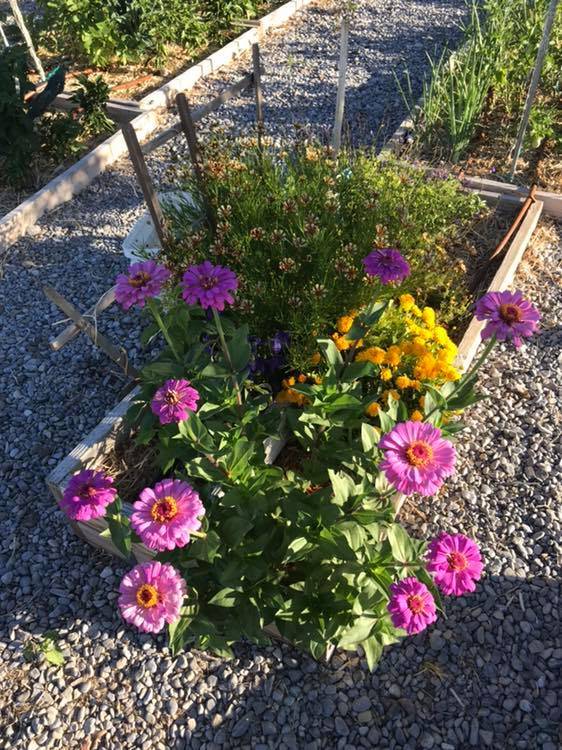
Over the last few weeks I’ve had the pleasure of watching my irises in bloom. Their fragrant flowers delight me and draw me outdoors. Now their blooms are fading, and it is time to turn my attention to flowers that will bloom in our summer heat.
I’ve been told by many local gardeners that flowers are a waste of water to grow. While I understand the need to conserve water in our parched region, I disagree. I plant flowers among my vegetables and it helps to increase pollination rates. Here are a few of my top flower picks for the summer garden that you can plant now.
Zinnia: Zinnias may just be the easiest flower to grow. Their large colorful flowers will keep blooming all summer, providing you with plenty of color in your garden. They are an annual, which means that they need to be replanted every year. Zinnias prefer full sun even in our hot climate. They are best planted directly into the garden. Their large seeds do not need to be planted deeply. Lightly cover them with soil and give them a good watering to get them started. They should be spaced at least 1 foot apart.
Portulaca: Portulaca is also called Moss Rose. It is a low spreading plant with lively flowers that bloom in a multitude of colors. Its small waxy leaves take on a succulent-like appearance though it is actually in the same plant family as Purslane. In my garden I like to use them as a living mulch.
Like Zinnias, Portulaca loves full sun. Broadcast its tiny seeds into the area you would like to plant them. I tend not to thin them out as they grow and end up with a variety of colors. Take care, as they spread easily if not controlled. Portulaca is an annual that will need to be planted every year for repeated blooms.
Gaillardia: Gaillardia, also known as Blanket Flower, form a small mound with bright orange and yellow blooms that are similar to daisies. They slowly spread, forming a blanket of beautiful flora that attracts bees and butterflies alike. They can reach up to 2 feet in circumference and reseed themselves easily throughout the garden.
Plant Gaillardia seeds fingertip deep and cover with soil at least 2 feet apart. Gaillardia is a perennial so it should survive the winter and keep blooming summer after summer.
Sunflower: Sunflowers come in a variety of sizes and colors from stalks with giant single blooms to stalks with multiple blooms that form over several weeks. Plant sunflowers every few weeks from February until May for continued blooming. Push their seeds lightly into the soil at least 1 foot apart and cover with mulch. You may need to protect the seedlings when they emerge as they seem to be a favorite for birds and rabbits.
Sunflower seeds are easy to save for replanting every year or for eating with some large head varieties. As the head starts to droop, tie a paper or cloth bag around it. As the sunflower dries up the seeds will fall into the bag and the birds will not have a chance to steal them. I’ve had great success with many of the mammoth varieties when saving the seeds and they get taller every year.
Ruellia: Ruellia is a low growing shrub with delicate purple petunia-like flowers. During summer it will bloom in the morning. Its blooms will fall off in the heat of the day and new blooms will open the next morning. Some nurseries sell it labeled as Mexican Petunia, though it is not in the Petunia family.
It can grow up to 12 feet high in some areas of the country but in my garden, they tend to get about 3 to 4 feet high and 2 feet in circumference. It does best with morning sun and afternoon shade.
Ruellia is a perennial that will die back in the winter and return year after year. It spreads easily through it’s roots and will need to be controlled if you wish to contain it to just one part of your garden.
Salvia: Salvia is another perennial that will bloom year after year. Its blooms form blue or red spears that shoot up toward the sky to a height of about 2 to 3 feet over bright green foliage. If you remove faded blooms it will keep blooming throughout the summer.
When new growth appears in the spring trim the dried-up stems to the ground. After 3 years it is beneficial to dig up and divide salvia in a similar manner to some bulb flowers like Irises.
These are just a few of my favorite flowers to plant for summer and there are many more options to explore. Give them a try and watch the butterflies and pollinators descend upon your garden this summer.
Terri Meehan is the Founder of Southern Nevada Gardening Association a regional group. She is a garden mentor and local farmer in Pahrump. Send questions or comments to her at sonvgarden@gmail.com